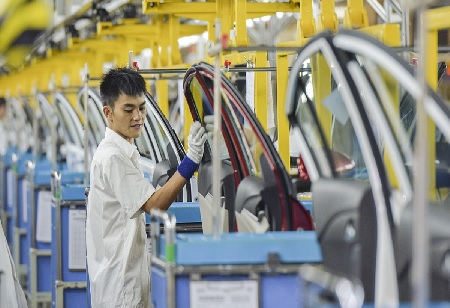India’s manufacturing sector experienced its slowest expansion in September since June, the S&P Global India Manufacturing Purchasing Managers’ Index (PMI) indicated, with the index easing to 55.1 from August’s 56.2. A PMI reading above 50 indicates an increase in firms’ activity levels, and September marked the 15th straight month of growth in manufacturing activity.
New export orders rose for the sixth successive month, and at the fastest pace since May 2022, even as the uptick in input costs dipped to the slowest rate in almost two years thanks to subdued global demand for raw materials and recession risks.
Indian producers responded to the relief on raw material cost surges by restricting increases in selling prices, dragging inflation in output prices to a seven-month low, the survey-based PMI signalled. Goods producers enjoyed a weaker inflationary environment as input costs rose at the slowest pace since October 2020 and just 8% of the surveyed companies reported higher purchasing prices. With inflation worries tamed,
businesses exuded more confidence about future prospects with the overall level of positive sentiment seen in September being the best in more than seven-and-a-half years. However, currency risks and the impact of a weaker rupee on inflation and interest rates could derail optimism during October, reckoned Pollyanna De Lima, economics associate director at S&P Global Market Intelligence.
“The latest set of PMI data show us that the Indian manufacturing industry remains in good shape, despite considerable global headwinds and recession fears elsewhere. There were softer, but substantial, increases in new orders and production in September, with some leading indicators suggesting that output looks set to expand further at least in the short term as firms seek to fulfil sales contracts and replenish stocks,” she said.
Ongoing increases in new work and efforts to lift production in September boosted job creation, which rose at the quickest pace in three months ‘albeit one that was slight overall’, S&P Global noted. While all broad manufacturing segments reported expansion, the capital goods sector reported the strongest growth in new orders, international sales and output. September marked the third month in a row when business sentiment improved. In August, when the PMI hit the highest level since November 2021, optimism among producers had hit a six-year high.
To accommodate higher sales and greater output needs, manufacturers also acquired more inputs after companies dug deep into their inventories in September, S&P Global said. “Stocks of finished goods fell at the fastest pace since February. Sustained input buying growth supported firms in their efforts to lift pre-production stocks in September. The rate of inventory accumulation was solid and quickened from August,” S&P Global said. However, suppliers’ performance clocked ‘a marginal deterioration’ after improvements in each of the previous three months.
